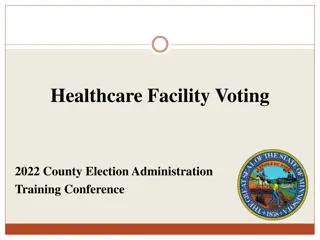Best Practices for Absentee Voting Programs
Explore key terminology, absentee logistics, inherent tradeoffs, and best-practice recommendations for absentee ballot programs. Learn about different types of absentee voting, ballot request and submission processes, voter validation requirements, and the challenges and benefits associated with absentee voting. Discover tips like accepting ballot requests through various means, providing pre-paid postage, and encouraging after-the-fact checking by voters to ensure their ballots are accepted and counted.
Download Presentation

Please find below an Image/Link to download the presentation.
The content on the website is provided AS IS for your information and personal use only. It may not be sold, licensed, or shared on other websites without obtaining consent from the author.If you encounter any issues during the download, it is possible that the publisher has removed the file from their server.
You are allowed to download the files provided on this website for personal or commercial use, subject to the condition that they are used lawfully. All files are the property of their respective owners.
The content on the website is provided AS IS for your information and personal use only. It may not be sold, licensed, or shared on other websites without obtaining consent from the author.
E N D
Presentation Transcript
Administration of Absentee Ballot Programs Barry C. Burden (University of Wisconsin) Brian J. Gaines (University of Illinois)
Key Terminology Precinct, Election-Day Voting Secret ballot cast at official polling place on official Election Day Convenience Voting Absentee: ballots can be obtained and returned by mail, in advance of Election Day, completed in uncontrolled setting of voter s choice Vote-by-Mail: all ballots cast absentee Early Voting: secret ballot cast at official polling places prior to official Election Day
Absentee Logistics Ballot requests Excuse or no-Excuse? How? By mail, internet, in-person, phone, ? Ballot submission How? By mail, in-person, by third-party Voter-validation: signature and witness requirements, multiple envelopes Ballot processing Accept or reject according to due date, voter-validation requirements When processed/counted When opened and votes counted
Inherent Tradeoffs (no best practice) Full across-state coordination on dates, format, etc. is unrealistic (contrary to robust federalism). Later deadlines could lower rejection rates, but burden officials, delay tabulation. Less difficult voter-validation can lower rejection rates, but facilitates fraud. Convenience voting complicates late ballot changes, but is popular and growing.
Best-Practice Recommendations 1. Early voting is more secure than absentee voting and thus should be preferred. Requests for absentee ballots should be accepted by a variety of means including mail, phone, fax, electronic mail, and Internet web sites. States should provide pre-paid postage with absentee ballots. The potential for online submission of absentee ballots should be studied, but approached with caution. States should facilitate and encourage after-the-fact checking by absentee voters to determine whether their ballots were accepted and counted. States should not tally absentee ballots in advance of Election Day. 2. 3. 4. 5. 6.

























